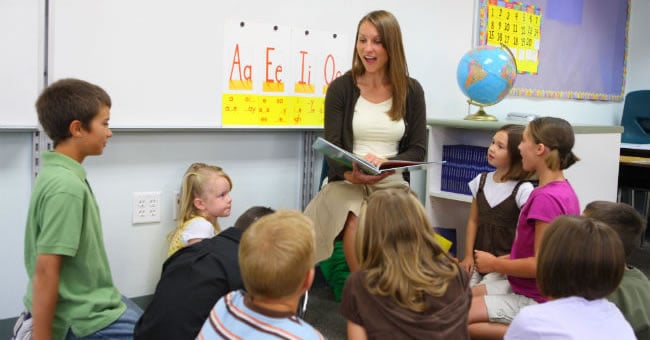
"The single most important activity for building the knowledge required for eventual success in reading is reading aloud to children. The benefits are greatest when the child is an active participant." – Anderson, Hiebert, Scott, & Wilkinson
What is an interactive read-aloud?
An interactive read–aloud is a literacy event whereby children actively engage in listening and talking about the text throughout the duration of the read–aloud. In contrast to the traditional read–aloud where children sit quietly as the teacher reads a text in its entirety prior to discussion (if any), the interactive read–aloud invites conversation from cover to cover. The teacher may read aloud a page, a few pages, or several chapters (depending upon the text and the age of the learner) and stop to discuss key ideas, illustrations, or other text features that enhance comprehension, note interesting details, make connections to other texts, or confirm/disconfirm predictions.
The Read-Aloud Books and CDs set contains books perfect for discussion. These stories include illustration, rhyme, and repetition. It is okay for children to interrupt the reading to share ideas, particularly when viewing an illustrated text or picture book. While teachers are focused on the print, students' eyes and minds are free to wander as they purposefully attend to both oral language and illustrations. It is not uncommon for children to notice the minute details in pictures or think about an illustration in such a way as to fine tune, enhance, or possibly skew the intended meaning of the text.
The Classic Read-Aloud Book and CDs set is perfect for children to engage illustrations. This, of course, serves to heighten understanding and promote grand conversations! Because children are actively participating in meaning making across the text, the time required for an interactive read–aloud is greater than the time required for a traditional read–aloud...but the additional time on the clock is well worth it!
Be sure to also check out Kaplan's selection of read aloud titles!
What should I think about when selecting a text for an interactive read-aloud?
- Texts you like (or liked as a child)
- Texts that are interesting and appealing to students (award winners included)
- Texts slightly more challenging than those children can read independently
- Texts that build on a topic currently being addressed in the curriculum
- Texts beyond fiction and nonfiction books—poetry and interesting/age-appropriate newspaper and magazine articles make for great read alouds too. Remember, non-fiction texts do not have to be read from cover to cover!
- Texts that present a new idea or a unique spin on an old idea
- Texts with an embedded second language (e.g., Tomas and the Library Lady by Pat Mora)
- Texts that are silly, quirky, or just plain fun to experience as a reader and listener
- Texts with no words! Illustrations are text too—in a wordless text, illustrations carry the full meaning.
What are the research based benefits of an interactive read aloud?
- Gives experiences with language that requires students to make sense of ideas.
- Enhances imagination, creativity, memory, and curiosity.
- Grows background knowledge and understanding of universal concepts.
- Helps students make connections across cultures to real life situations.
- Increases students' listening skills and attention spans.
- Supports learning about conventions of texts.
- Permits students to hear what proficient reading sounds like.
- Introduces students to the pleasures of reading and texts of all kinds.
- Builds classroom community.
- Promotes discussions about topics in critical and significant ways.
- Improves independent reading proficiency.
- Encourages children to focus on important text ideas and reflect on them.
- Increases students' interest in independent reading.
Putting It All Together
R – Read various genres with high interest, rich language, and layers of meaning
E – Engage students purposefully in making powerful schema connections
A – Adequate time needed to conduct interactive read-aloud sessions
D – Demonstrate comprehension strategies and reading processes
A – Anticipate need to activate prior knowledge/build schema for understanding
L – Listen to and affirm student discussion contributions
O – Opportunities should be devised to explore text in personal and exciting ways
U – Use good judgement about amount of ongoing interaction throughout read–aloud
D – Decide how to best phrase questions and predicting invitations ahead of time
"You're never too old, too wacky, too wild, to pick up a book and read to a child." – Dr. Seuss
About the Author
Dr. Debbie Linville has been teaching for over 30 years and her passion is enabling educators to promote the proficient, joyful reading and writing lives of children.
